- Material on [[brainstorming]] at [[Kyoto University Summer Design School 2014]] "[[Designing ways to learn]]".
 Kyoto University Summer Design School2014Kyoto University Summer Design School2014NISHIO Hirokazu(c)2014NISHIO Hirokazu (Cybozu Labs)
Kyoto University Summer Design School2014Kyoto University Summer Design School2014NISHIO Hirokazu(c)2014NISHIO Hirokazu (Cybozu Labs)
 Brainstorming Brainstorming Brainstorming
Brainstorming Brainstorming Brainstorming
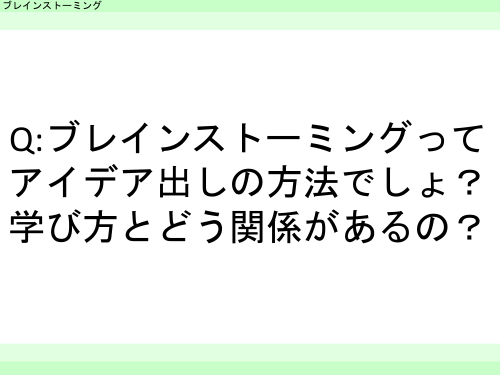 Q: Brainstorming is a way of generating ideas, right? What does that have to do with way of learning?
Q: Brainstorming is a way of generating ideas, right? What does that have to do with way of learning?
 Ideas, hypotheses, plans, and the feeling of “getting it” all have a common root.
Ideas, hypotheses, plans, and the feeling of “getting it” all have a common root.
 You can’t know if an idea will work unless you implement and test it.
You can’t know if an idea will work unless you implement and test it.
 Hypotheses must be tested and verified to know if they are correct.
Hypotheses must be tested and verified to know if they are correct.
 You can’t know if a plan will work as expected unless you execute and verify it.
You can’t know if a plan will work as expected unless you execute and verify it.
 If you don’t verify that you “get it,” you don’t know if you really understand it.
If you don’t verify that you “get it,” you don’t know if you really understand it.
 All four are “newly created by Knowledge Combining and need to be validated in the future.”
All four are “newly created by Knowledge Combining and need to be validated in the future.”
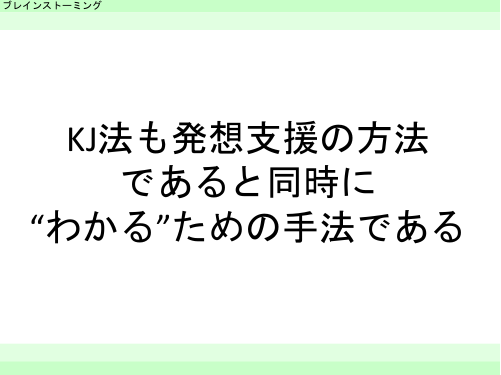
- KJ method is also a method to support ideas as well as a method to “understand
 Purpose of this slide
Removing Assumptions About Breast
Purpose of this slide
Removing Assumptions About Breast
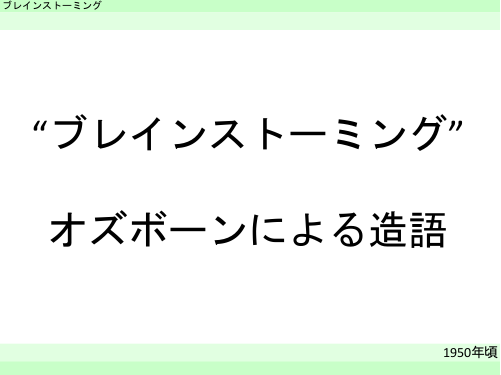 Brainstorming” a term coined by Osborne
Brainstorming” a term coined by Osborne
- Circa 1950.
 Four items often referred to as “rules of brainstorming
Four items often referred to as “rules of brainstorming
 Four principles of brainstorming
Four principles of brainstorming
- Do not judge or draw conclusions (do not conclude)
- Refrain from making judgments and conclusions that limit the free extraction of ideas. …
- Welcome crude ideas (freewheeling)
- Emphasizes quirky thinking and unique, novel ideas rather than ideas that anyone might come up with. …
- Emphasize quantity (quantity before quality)
- Many ideas, from many different angles. …
- Coupling and developing ideas (Coupling Improvement)
- By attaching or partially changing separate ideas, a new idea is created.
- Taking advantage of the opinions of others is encouraged.
- Excerpted from Wikipedia, Brainstorming
 What is the source of this rule?
What is the source of this rule?
 “At the opening, the leader should explain the following with Presenting the Problem: (1)…(2)…(3)…(4)…(5). (1)…(2)…(3)…(4)…
Osborn, “Making the most of your creativity,” p. 272, boldface by the author.
“At the opening, the leader should explain the following with Presenting the Problem: (1)…(2)…(3)…(4)…(5). (1)…(2)…(3)…(4)…
Osborn, “Making the most of your creativity,” p. 272, boldface by the author.
 Brainstorming leaders should state these notes in their own words.
Brainstorming should always be informal, because brainstorming should always be informal.”
Making the Most of Creativity, p. 273 boldface by the author
Brainstorming leaders should state these notes in their own words.
Brainstorming should always be informal, because brainstorming should always be informal.”
Making the Most of Creativity, p. 273 boldface by the author
 First, present the problem.
State the four caveats in your own words
First, present the problem.
State the four caveats in your own words
 Is this all? NO!
Is this all? NO!
 “The only thing that must be strictly formalized is the record of all ideas submitted.”
Making the Most of Creativity, p. 273 boldface by the author
“The only thing that must be strictly formalized is the record of all ideas submitted.”
Making the Most of Creativity, p. 273 boldface by the author
 brainstorming
Record all ideas
First, present the problem.
State the four caveats in your own words
The most important rule is to record all ideas
brainstorming
Record all ideas
First, present the problem.
State the four caveats in your own words
The most important rule is to record all ideas
 “Write down the flow of ideas on something so that all members can see it.” An additional rule that IDEO has introduced. “A company that conceives !” p.70
“Write down the flow of ideas on something so that all members can see it.” An additional rule that IDEO has introduced. “A company that conceives !” p.70
 In a book written in 1986, it is written that “the record keeper takes notes from one end to the other.
Why has the importance of records been forgotten… “Organizational Thought” p.168
In a book written in 1986, it is written that “the record keeper takes notes from one end to the other.
Why has the importance of records been forgotten… “Organizational Thought” p.168
 Brainstorming Osborne also says: “Make sure that a copy of this record is given to everyone after the meeting.
Brainstorming Osborne also says: “Make sure that a copy of this record is given to everyone after the meeting.
 Brainstorming Summary so far “Recording ideas” is the most important rule, which is neglected in many cases.
Brainstorming Summary so far “Recording ideas” is the most important rule, which is neglected in many cases.
 Brainstorming brainstorming, you know, a less rigid meeting where you verbally bounce ideas off each other.
Brainstorming brainstorming, you know, a less rigid meeting where you verbally bounce ideas off each other.
 Brainstorming brainstorming, you know, a less rigid meeting where you verbally bounce ideas off each other.
Brainstorming brainstorming, you know, a less rigid meeting where you verbally bounce ideas off each other.
 Brainstorming Osborn’s proposal, followed by more than 50 experiments, revealed a surprising fact…
Brainstorming Osborn’s proposal, followed by more than 50 experiments, revealed a surprising fact…
 brainstorming
When done orally, the quantity and quality of ideas is higher when done individually than in groups of multiple people McGrath (1984)
brainstorming
When done orally, the quantity and quality of ideas is higher when done individually than in groups of multiple people McGrath (1984)
 Brainstorming 1. Hindering productivityListening to others takes time away from your own thinking, topics become fixed, etc. “[A group of mediocre geniuses can beat a lone genius.
Brainstorming 1. Hindering productivityListening to others takes time away from your own thinking, topics become fixed, etc. “[A group of mediocre geniuses can beat a lone genius.
 Brainstorming 2. Social Inhibition Cannot speak up for fear of what other members will think of you “A group of mediocre geniuses can beat a lone genius,” p. 84.
Brainstorming 2. Social Inhibition Cannot speak up for fear of what other members will think of you “A group of mediocre geniuses can beat a lone genius,” p. 84.
 Brainstorming 3. Social Laziness Responsibility is distributed to the group and individual desperation is lost “A group of mediocre geniuses can beat a lone genius” p. 84
Brainstorming 3. Social Laziness Responsibility is distributed to the group and individual desperation is lost “A group of mediocre geniuses can beat a lone genius” p. 84
 Brainstorm how to solve this problem?
Brainstorm how to solve this problem?
 Brainstorming “Brainwriting” “Brainwriting” Makoto Takahashi to write individually and then share” brainwriting “Silent Idea Conference” to come up with a large number of ideas in a short period of time.
Brainstorming “Brainwriting” “Brainwriting” Makoto Takahashi to write individually and then share” brainwriting “Silent Idea Conference” to come up with a large number of ideas in a short period of time.
 Brainstorming “electronic brainstorming” replaces verbal statements with chat, which has the advantage that it can be anonymized if necessary.
Brainstorming “electronic brainstorming” replaces verbal statements with chat, which has the advantage that it can be anonymized if necessary.
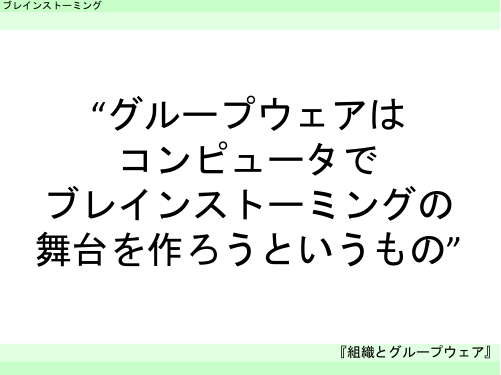 Brainstorming “Groupware is about creating a stage for brainstorming with computers” Organization and Groupware.
Brainstorming “Groupware is about creating a stage for brainstorming with computers” Organization and Groupware.
 Brainstorming summary so far “verbal” is not essential, in fact, it hurts productivity.
Brainstorming summary so far “verbal” is not essential, in fact, it hurts productivity.
 Brainstorming individuals will increase the amount of ideas after training in brainstorming → beneficial even when done alone “A group of mediocre geniuses can beat a lone genius.”
Brainstorming individuals will increase the amount of ideas after training in brainstorming → beneficial even when done alone “A group of mediocre geniuses can beat a lone genius.”
 Brainstorm write then share → no need to do it at the same time
Brainstorm write then share → no need to do it at the same time
 Brainstorming “The Internet has made it easier to gather ideas on a large scale.
Brainstorming “The Internet has made it easier to gather ideas on a large scale.
 Brainstorming “team members get together” does not fit the image.
Brainstorming “team members get together” does not fit the image.
 BrainstormingBrainstorming principles have been applied to create apparently different methods.
BrainstormingBrainstorming principles have been applied to create apparently different methods.
 Brainstorming: It is important to think about the “why” of brainstorming, rather than just assuming “what is brainstorming?
Brainstorming: It is important to think about the “why” of brainstorming, rather than just assuming “what is brainstorming?
 The problem with brainstorming brainstorms “quantity over quality” but too much quantity overwhelms people.
The problem with brainstorming brainstorms “quantity over quality” but too much quantity overwhelms people.
 Brainstorming One Solution Voting IDEO allows members present to vote on their favorite ideas after the brainstorming session is over.
Brainstorming One Solution Voting IDEO allows members present to vote on their favorite ideas after the brainstorming session is over.
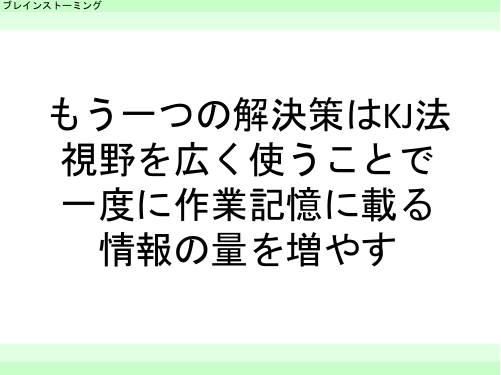 Brainstorming Another solution is to use the KJ method, which increases the amount of information that can be placed in the working memory at one time by using a wide field of view.
Brainstorming Another solution is to use the KJ method, which increases the amount of information that can be placed in the working memory at one time by using a wide field of view.
 Brainstorming Basic structure of this work is also brainstorming → KJ method “each person writes and then shares” is equivalent to “recording and distributing ideas”.
Brainstorming Basic structure of this work is also brainstorming → KJ method “each person writes and then shares” is equivalent to “recording and distributing ideas”.
 References
-A. Osborn (2008) “Harnessing Creativity: 38 Ways to Get Ideas”, translated by Akira Toyoda, Sogensha, Tom Kelly, Jonathan Littman (2002) “The Idea Company! The World’s Best Design Firm, IDEO: The Art of Innovation”, translated by Chikara Suzuki and Naoko Shuoka, Hayakawa Shobo, Shigehiko Toyama (1986) “Organizing Thoughts”, Chikuma Bunko, Makoto Takahashi (2007) “Brain Writing: The ‘Silent Idea Conference’ for generating a large number of ideas in a short time”, McGrath, J. E. (1984) “[Group Ideas Company! E. (1984) “Groups: Interaction and performance” Englewood Cliffs, NJ: Prentice Hall Alan R. Dennis and Joseph S. Valacich (1993) “Computer Brainstorms: More Heads Are Better Than One” Journal of Applied Psychology 1993, Vol 78, No. 4, 531-537 Keith Sawyer (2009) “[A group of mediocre geniuses can Sean Abrahamson (2014) “Crowdstorming: How to Create Ideas by Fully Leveraging the Power of Outside Organizations” Hankyu Communications, Inc.
References
-A. Osborn (2008) “Harnessing Creativity: 38 Ways to Get Ideas”, translated by Akira Toyoda, Sogensha, Tom Kelly, Jonathan Littman (2002) “The Idea Company! The World’s Best Design Firm, IDEO: The Art of Innovation”, translated by Chikara Suzuki and Naoko Shuoka, Hayakawa Shobo, Shigehiko Toyama (1986) “Organizing Thoughts”, Chikuma Bunko, Makoto Takahashi (2007) “Brain Writing: The ‘Silent Idea Conference’ for generating a large number of ideas in a short time”, McGrath, J. E. (1984) “[Group Ideas Company! E. (1984) “Groups: Interaction and performance” Englewood Cliffs, NJ: Prentice Hall Alan R. Dennis and Joseph S. Valacich (1993) “Computer Brainstorms: More Heads Are Better Than One” Journal of Applied Psychology 1993, Vol 78, No. 4, 531-537 Keith Sawyer (2009) “[A group of mediocre geniuses can Sean Abrahamson (2014) “Crowdstorming: How to Create Ideas by Fully Leveraging the Power of Outside Organizations” Hankyu Communications, Inc.
 Brainstorm what Osborne says: “Distribute a brief thank-you note to everyone from those who will benefit from the proposal,” “Making the Most of Creativity,” p. 273.
Brainstorm what Osborne says: “Distribute a brief thank-you note to everyone from those who will benefit from the proposal,” “Making the Most of Creativity,” p. 273.
 Brainstorming Osborne says, “If an idea is adopted, report back to the people in the meeting and encourage them to do so.
Brainstorming Osborne says, “If an idea is adopted, report back to the people in the meeting and encourage them to do so.
 About this SlideThis slide is part of the “Designing for Learning” lecture material given by NISHIO Hirokazu and Yoshinori Takezako of Cybozu Labs at Kyoto University Summer Design School 2014. Other slides are available at http://nhiro.org/kuds2014/で見つけることができます.
About this SlideThis slide is part of the “Designing for Learning” lecture material given by NISHIO Hirokazu and Yoshinori Takezako of Cybozu Labs at Kyoto University Summer Design School 2014. Other slides are available at http://nhiro.org/kuds2014/で見つけることができます.
This page is auto-translated from /nishio/ブレインストーミング解説 using DeepL. If you looks something interesting but the auto-translated English is not good enough to understand it, feel free to let me know at @nishio_en. I’m very happy to spread my thought to non-Japanese readers.